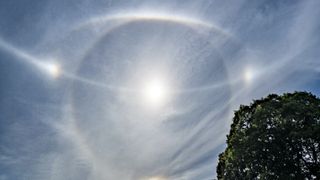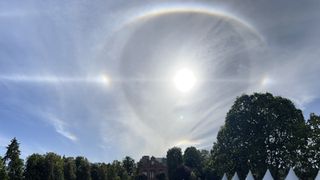Ethereal 'halo' and light arcs around the sun captured in photos of ultra-rare phenomena
At least three separate optical phenomena are visible in the new images. Each of which is created by light refracting through millions of perfectly aligned ice crystals in the upper atmosphere.

A scientist recently snapped a series of shining arcs and halos of light surrounding the sun in the sky above the U.K., including an exceptionally rare ring of light that circled the entire sky.
Alan Fitzsimmons, an astronomer at Queen's University Belfast in Northern Ireland, captured the unusual light show above Belfast's Botanic Gardens on May 28. The display lasted around 30 minutes, Fitzsimmons told Live Science.
Some of the bizarre glowing rays were also spotted across other parts of Northern Ireland, as well as in northern England and Scotland, according to Spaceweather.com.
The arcs and halos are caused by millions of tiny, perfectly positioned ice crystals in the upper Earth atmosphere, which often accompany thin cirrus clouds, Fitzsimmons said. "If the winds are very uniform up there, the hexagonal-shaped crystals align," he added. "This allows the sunlight refracting through them to combine, just as light refracts through a prism, producing arcs and circles of sunlight."

Fitzsimmons' image includes at least three different confirmed optical phenomena: a 22-degree halo, the large circle surrounding the sun; a pair of "sundogs," the bright points on each side of the 22-degree halo; and a complete parhelic circle, the line that bisects the circle, which also forms a full circle around the entire sky.
A full parhelic circle is very rare because it requires at least five internal reflections from millions of individual ice crystals, all catching sunbeams simultaneously, according to Spaceweather.com.
Get the Space.com Newsletter
Breaking space news, the latest updates on rocket launches, skywatching events and more!
The images also may include features of a circumscribed halo and a supralateral arc, which form the "eyelids" above and below the 22-degree halo, according to Spaceweather.com.

The parhelic circle is the rarest and most "impressive feature" in the image, Fitzsimmons said. It is something he has seen only a couple of times before, he added. But the other phenomena are more common than most people realize.
"The sun can be quite bright when they [the phenomena] are visible, so to notice them, you need to block out the sun with your thumb or a tree," Fitzsimmons said. "But anytime it's sunny with high-altitude wispy clouds, it's worth taking a look to see if there is a halo or maybe something more."
On May 30, a photographer in Finland also caught a shot of a rainbow-colored ring of light, known as a pollen corona, surrounding the sun. These rings, which are created by light scattering off of pollen grains in the air, are also hard to spot unless part of the sun's light has been blocked out.
Tiny atmospheric ice crystals can also create a range of other weird visual phenomena, such as polar stratospheric clouds, which shine like rainbows in the Arctic, and night-shining clouds (also called noctilucent clouds), which will become more visible to people in the Northern Hemisphere during June and July.
This story was originally posted on Live Science.
Join our Space Forums to keep talking space on the latest missions, night sky and more! And if you have a news tip, correction or comment, let us know at: community@space.com.

Harry is a U.K.-based staff writer at Live Science. He studied Marine Biology at the University of Exeter (Penryn campus) and after graduating started his own blog site "Marine Madness," which he continues to run with other ocean enthusiasts. He is also interested in evolution, climate change, robots, space exploration, environmental conservation and anything that's been fossilized. When not at work he can be found watching sci-fi films, playing old Pokemon games or running (probably slower than he'd like).
